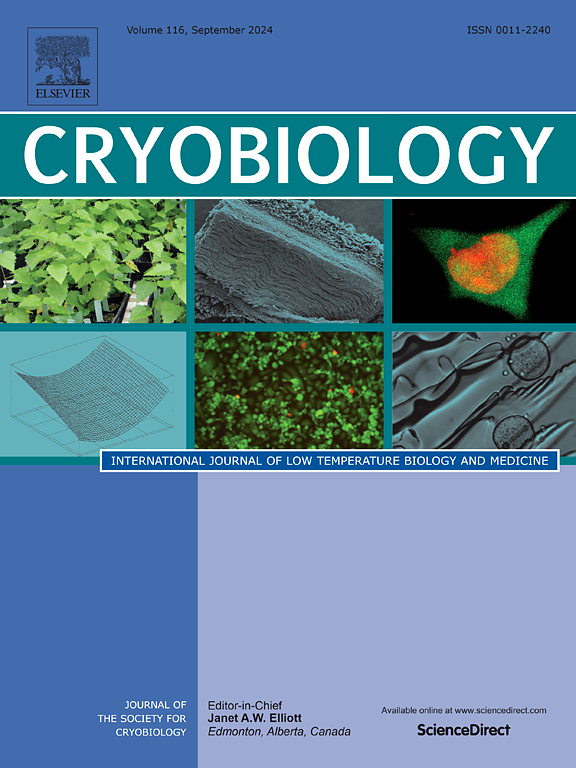Supplemental effect of metallic nanoparticles on cryopreserved semen quality, lipid peroxidation, sperm head ultrastructure and field fertility levels in crossbred (Hampshire x Niang Megha) boars
IF 2.3
3区 生物学
Q2 BIOLOGY
引用次数: 0
Abstract
Reactive oxygen species (ROS) produced by sperm contributes to oxidative stress (OS), leading to a decline in sperm quality. Different antioxidants have shown potential in preventing such damage. The present study explored the effect of metallic nanoparticle (NPs) supplementation on sperm quality in cryopreserved boar spermatozoa. Forty-two (42) ejaculates (7 ejaculates per animal) were collected from six (6) physically and sexually healthy and fertile Lumsniang (Hampshire x Niang Megha) crossbred boars, aged 18–42 months and then diluted in Beltsville thawing solution (BTS) extender containing the different treatments (CON: no NP addition; 10 μM ZnO NPs, 1 μg Se NPs and 0.192 mg Fe3O4 NPs per mL of semen). Semen was diluted, packed into 0.5 mL French medium straws, and subsequently frozen in liquid nitrogen (LN2). Sperm quality, lipid peroxidation (LPO), antioxidant enzyme levels, ultrastructural sperm head morphology and field fertility levels were determined. Significantly (p < 0.05) higher sperm in vitro quality attributes were recorded in the zinc oxide (ZnO) and selenium (Se) NP treatments in comparison to CON whereas iron-oxide (Fe3O4) NP treatment significantly (p < 0.05) lowered sperm quality. Post-thaw LPO levels significantly (p < 0.05) decreased in the ZnO and Se NP groups when compared to CON. LPO levels were significantly (p < 0.05) higher in the Fe3O4 NP group. The ZnO and Se NP treatments showed significantly (p < 0.05) higher post-thaw antioxidant enzyme levels. Ultrastructurally, Group 1 spermatozoa were significantly (p < 0.05) higher and Group 2 were significantly (p < 0.05) lower in the ZnO and Se NP supplemented group in comparison to CON. No significant (p > 0.05) difference was observed in the in vivo pregnancy rate; however, the ZnO and Se NP treatments significantly (p < 0.05) enhanced the average litter sizes at birth and weaning compared to CON. In conclusion, 10 μM ZnO and 1 μg Se NPs improved post-thaw quality of boar spermatozoa and safeguarded the ultrastructure of their membranes. On the other hand, 0.192 mg Fe3O4 NPs had deleterious effects on sperm in vitro quality.
金属纳米颗粒对汉普郡×娘梅杂交公猪冻存精液质量、脂质过氧化、精子头超微结构和田间育性水平的影响
精子产生的活性氧(ROS)有助于氧化应激(OS),导致精子质量下降。不同的抗氧化剂已显示出预防这种损害的潜力。本研究探讨了添加金属纳米颗粒(NPs)对猪冷冻精子质量的影响。选取6头18-42月龄身体健康、生殖力良好的拉姆斯尼桑(汉普郡×尼梅加)杂交公猪,收集42头(每头7头)射精,用不同处理(CON:不添加NP;10 μM ZnO NPs、1 μg Se NPs和0.192 mg Fe3O4 NPs / mL精液)。将精液稀释,装入0.5 mL法式中吸管中,随后在液氮(LN2)中冷冻。测定精子质量、脂质过氧化(LPO)、抗氧化酶水平、精子头部超微结构形态和田间育性水平。显著(p <;0.05),氧化锌(ZnO)和硒(Se) NP处理的精子体外质量属性显著高于对照组,而氧化铁(Fe3O4) NP处理的精子体外质量属性显著高于对照组(p <;0.05)降低精子质量。解冻后LPO水平显著(p <;与con相比,ZnO和Se NP组LPO水平显著降低(p <;Fe3O4 NP组显著高于0.05)。ZnO和Se NP处理显著(p <;0.05)解冻后抗氧化酶水平升高。超微结构上,1组精子显著(p <;0.05),组2显著升高(p <;0.05),与对照组相比,氧化锌和硒NP添加组显著降低。体内妊娠率差异为0.05);然而,ZnO和Se NP处理显著(p <;由此可见,10 μM ZnO和1 μg Se NPs均能改善猪精子解冻后的质量,并保护其膜的超微结构。另一方面,0.192 mg Fe3O4 NPs对精子体外质量有不良影响。
本文章由计算机程序翻译,如有差异,请以英文原文为准。
求助全文
约1分钟内获得全文
求助全文
来源期刊

Cryobiology
生物-生理学
CiteScore
5.40
自引率
7.40%
发文量
71
审稿时长
56 days
期刊介绍:
Cryobiology: International Journal of Low Temperature Biology and Medicine publishes research articles on all aspects of low temperature biology and medicine.
Research Areas include:
• Cryoprotective additives and their pharmacological actions
• Cryosurgery
• Freeze-drying
• Freezing
• Frost hardiness in plants
• Hibernation
• Hypothermia
• Medical applications of reduced temperature
• Perfusion of organs
• All pertinent methodologies
Cryobiology is the official journal of the Society for Cryobiology.
 求助内容:
求助内容: 应助结果提醒方式:
应助结果提醒方式:


